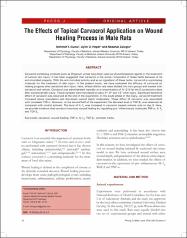| dc.contributor.author | Günal, Mehmet Yalçın | |
| dc.contributor.author | Okçu Heper, Aylin | |
| dc.contributor.author | Zaloğlu, Nezahat | |
| dc.date.accessioned | 10.07.201910:49:13 | |
| dc.date.accessioned | 2019-07-10T19:35:42Z | |
| dc.date.available | 10.07.201910:49:14 | |
| dc.date.available | 2019-07-10T19:35:42Z | |
| dc.date.issued | 2014 | en_US |
| dc.identifier.citation | Günal, M. Y., Okçu Heper, A. ve Zaloğlu, N. (2014). The effects of topical carvacrol application on wound healing process in male rats. Pharmacognosy Journal, 6(3), 10-14. https://dx.doi.org/10.5530/pj.2014.3.2 | en_US |
| dc.identifier.issn | 0975-3575 | |
| dc.identifier.uri | https://hdl.handle.net/20.500.12511/910 | |
| dc.identifier.uri | https://dx.doi.org/10.5530/pj.2014.3.2 | |
| dc.description.abstract | Carvacrol containing products such as Origanum onites have been used as phytotherapeutic agents in the treatment of serious skin injury. It has been suggested that carvacrol is the active component of these herbs because of its anti-microbial property. With the anti-microbial activity and as an ingredient of these herbs, carvacrol is a promising molecule for the treatment of skin injury. In the present study, we have evaluated the efficacy of carvacrol on healing progress after excisional skin injury. Here, Wistar-Albino rats were divided into two groups and treated with carvacrol and vehicle. Carvacrol was administrated topically at a concentration of %12.5 for the 5 consecutive days after excisional skin injury. Tissue samples were harvested on days 3rd, 8th and 12th after injury. Significant beneficial effect of carvacrol was observed at the end of the experiment. In the acute phase of the injury, carvacrol treatment increased tissue granulation and decreased wound depth moderately. These effect of carvacrol was associated with increased TNF-?. However, at the second half of the experiment the elevated level of TGF-B1 was observed as compared with control animals. The level of IL-1ß was increased in carvacrol treated animals only on day 8. Here, we provide evidence that carvacrol improves wound healing by regulating pro- inflammatory molecules TNF-?, IL-1ß and TGF-ß1. | en_US |
| dc.language.iso | eng | en_US |
| dc.publisher | EManuscript Services | en_US |
| dc.rights | info:eu-repo/semantics/openAccess | en_US |
| dc.subject | Aromatic Herbs | en_US |
| dc.subject | Carvacrol | en_US |
| dc.subject | IL-1ß | en_US |
| dc.subject | TGF-ß1 | en_US |
| dc.subject | TNF-? | en_US |
| dc.subject | Wound Healing | en_US |
| dc.title | The effects of topical carvacrol application on wound healing process in male rats | en_US |
| dc.type | article | en_US |
| dc.relation.ispartof | Pharmacognosy Journal | en_US |
| dc.department | İstanbul Medipol Üniversitesi, Tıp Fakültesi, Temel Tıp Bilimleri Bölümü, Fizyoloji Ana Bilim Dalı | en_US |
| dc.authorid | 0000-0001-7702-2441 | en_US |
| dc.identifier.volume | 6 | en_US |
| dc.identifier.issue | 3 | en_US |
| dc.identifier.startpage | 10 | en_US |
| dc.identifier.endpage | 14 | en_US |
| dc.relation.publicationcategory | Makale - Uluslararası Hakemli Dergi - Kurum Öğretim Elemanı | en_US |
| dc.identifier.doi | 10.5530/pj.2014.3.2 | en_US |
| dc.identifier.scopusquality | Q3 | en_US |


















